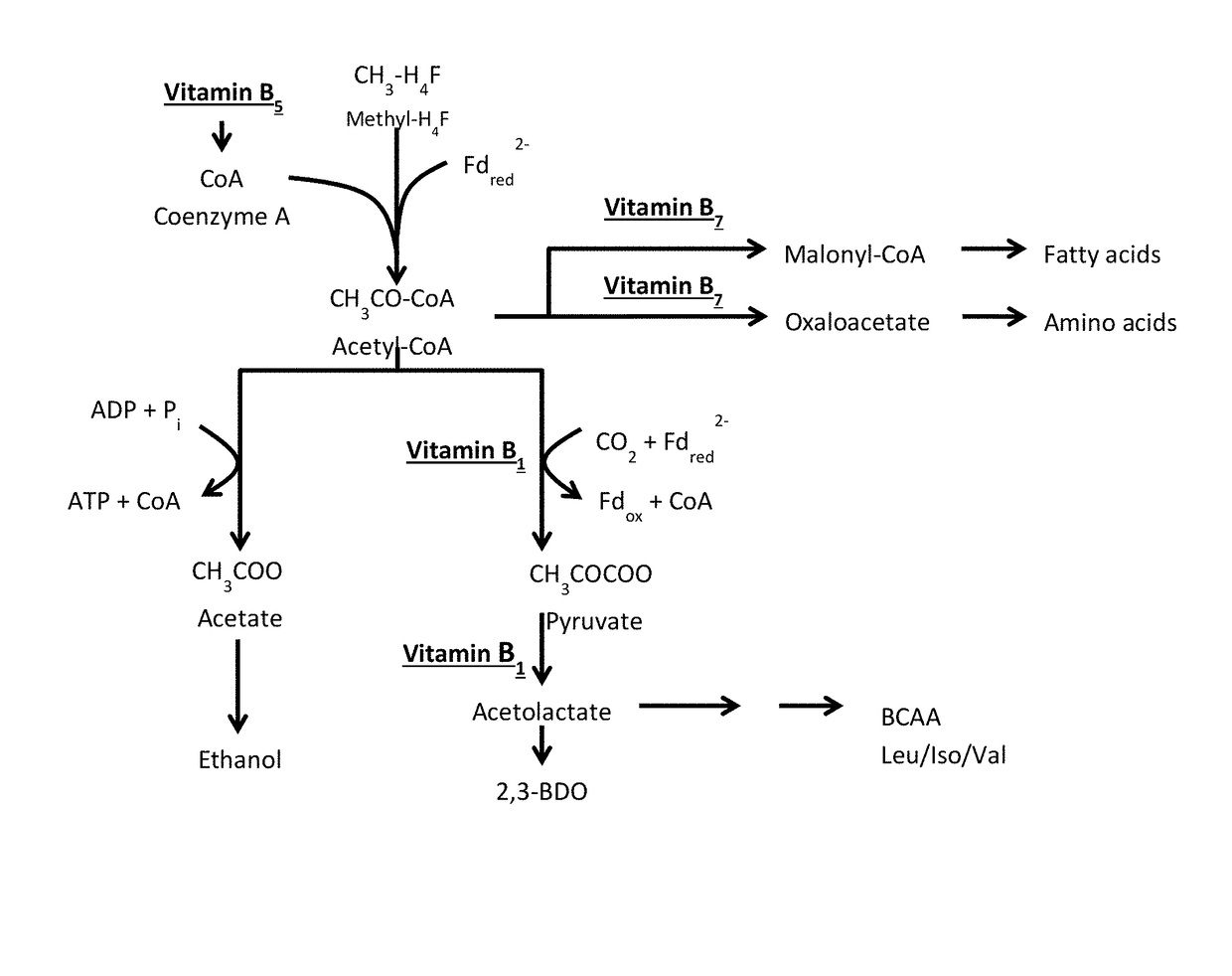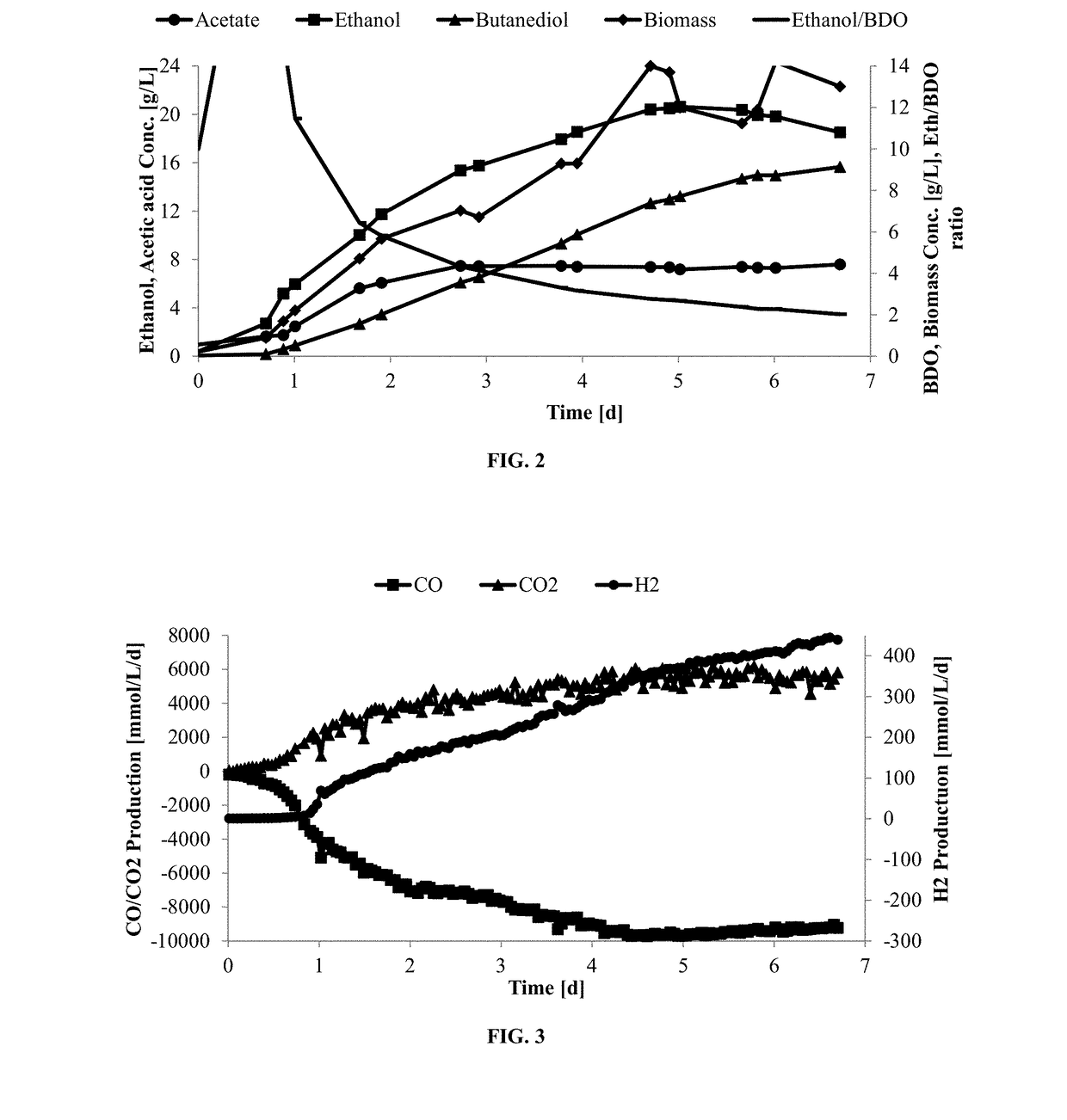Fermentation process for the production and control of pyruvate-derived products
a technology of fermentation process and pyruvate, which is applied in the direction of fermentation, biofuels, etc., can solve the problems of reducing the production efficiency of bdo, increasing the cost of industrial plants, and releasing co into the atmosphere, so as to reduce the ratio of ethanol to bdo and increase the production of bdo
- Summary
- Abstract
- Description
- Claims
- Application Information
AI Technical Summary
Benefits of technology
Problems solved by technology
Method used
Image
Examples
example 1
Effect of Increasing Vitamin B5 Concentration on 2,3-BDO Production
[0126]This experiment was carried out according to the general fermentation process described above. During the course of the fermentation experiment, gas flow and agitation were increased to minimize acetate and maximize ethanol production. Dilution rate and bacterial dilution rate were adjusted so that by day 5.0 these were 1.8 day−1 and 0.85 day−1, respectively. These values were maintained for the remainder of the fermentation. Between day 6.0-day 8.0 stable data was achieved with the B5 feed rate of 198 μg / g-cell produced. The results achieved during this stable period are summarised in Table 2.
[0127]
TABLE 2Results of fermentation with 198 μg / g-cell produced of vitamin B5MeasureConcentrationBiomass10.62g / LCO uptake8.4mol / L / dayEthanol18.69g / LAcetate7.75g / L2,3-BDO4.8g / LSpecific 2,3-BDO production rate0.81 g 2,3-BDO / g-biomass / daySpecific Ethanol production rate3.17 g ethanol / g-biomass / dayEthanol:2,3-BDO ratio3.8:1
[...
example 3
Effect of Increasing Vitamin B5 from Start of Fermentation on 2,3-BDO Production
[0131]The example above can be compared to results when excess B5 vitamin is present in the fermentation media throughout the fermentation. During this fermentation experiment gas and agitation were increased to minimize acetate and maximize ethanol production. Dilution rate and bacterial dilution rate were adjusted by day 4.0 to 1.7 day−1 and 0.65 day−1 respectively. In this case the 2,3-BDO concentration reached 9 g / L with an ethanol:2,3-BDO ratio of 2:1 (FIG. 2), and a CO uptake of 9.4 mol / L / day (FIG. 3). The feed rate of B5 vitamin throughout the fermentation was >2000 μg / g-cell produced. During day 6.0 to 7.0 as the biomass and 2,3-BDO production flattened out the feed rate of B5 vitamin was 2011 μg / g-cell produced. The specific 2,3-BDO production rate was 1.2 g / day per g-biomass, the specific ethanol production rate was 2.4 g / day per g-biomass.
example 4
Effect of Increasing / Decreasing Vitamin B1 Concentration on 2,3-BDO Production
[0132]A fermentation was started using the general fermentation process with gas and agitation were increased to minimize acetate and maximize ethanol production. Dilution rate and bacterial dilution rate were adjusted by day 4.0 to 2.0 day-1 and 1.2 day-1, respectively. These values were maintained for the remainder of the fermentation. Between day 10.0-day 14.0 stable data was achieved, the feed rate of B1 during this time was 303 μg / g-cell produced. The data achieved is summarized in Table 4.
[0133]
TABLE 4Results from excess vitamin B1 (303 μg / g cell produced)MeasureConcentrationEthanol:2,3BDO ratio4.7:12,3-BDO3.4g / LBiomass5.79g / LEthanol16.05g / LCO uptake8.0mol / L / daySpecific 2,3-BDO production rate1.17 g 2,3-BDO / g biomass / daySpecific Ethanol production rate5.54 g ethanol / g biomass / day
[0134]On day 14.1 the concentration of B1 in media was decreased to reduce the specific B1 feed rate with all other operati...
PUM
| Property | Measurement | Unit |
|---|---|---|
| temperature | aaaaa | aaaaa |
| temperature | aaaaa | aaaaa |
| pH | aaaaa | aaaaa |
Abstract
Description
Claims
Application Information
 Login to View More
Login to View More - R&D
- Intellectual Property
- Life Sciences
- Materials
- Tech Scout
- Unparalleled Data Quality
- Higher Quality Content
- 60% Fewer Hallucinations
Browse by: Latest US Patents, China's latest patents, Technical Efficacy Thesaurus, Application Domain, Technology Topic, Popular Technical Reports.
© 2025 PatSnap. All rights reserved.Legal|Privacy policy|Modern Slavery Act Transparency Statement|Sitemap|About US| Contact US: help@patsnap.com



